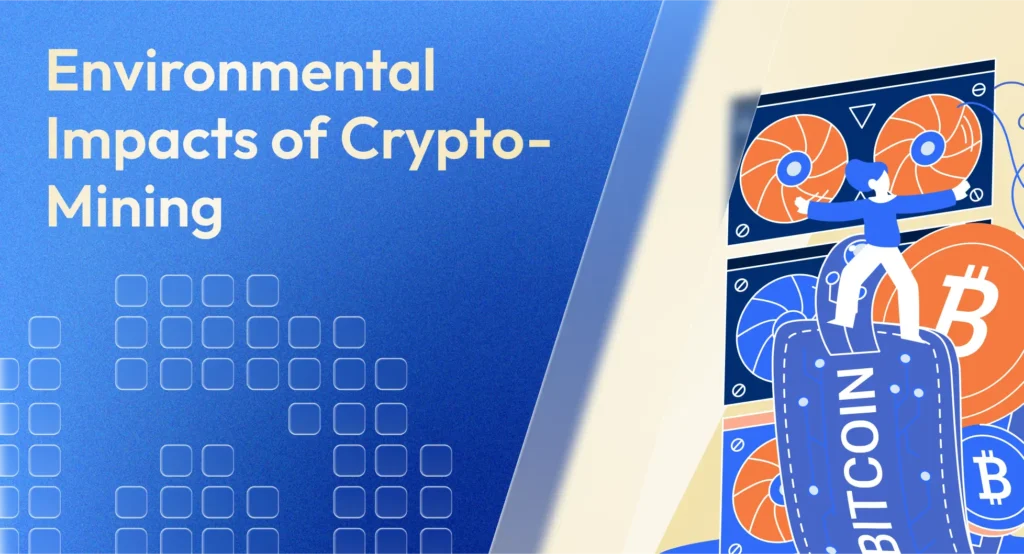The crypto mining sector, like the mining industry, has major environmental consequences as a result of the energy-intensive process through which coins are made. But unlike the mining sector, the cryptocurrency industry may begin to change its operations.
Let’s know why Bitcoin mining is unsustainable and what fresh developments may change that.
What’s the Crypto Mining Environmental Impact?
To properly understand the environmental effects of Bitcoin, you first need to understand the process by which new coins in a cryptocurrency are created. Because cryptocurrencies are not governed by a centralized body, the blockchain relies on users to confirm transactions and update the blockchain with new blocks of data. To prevent fraudulent actors from attempting to manipulate this additional information, these blockchains must be extremely difficult and expensive to validate. As a result, most cryptocurrencies include proof of work.
Proof of work is a consensus technique that enables users to validate Bitcoin transactions by resolving a difficult mathematical problem. The transaction is validated and a certain amount of cryptocurrency is rewarded to the first individual who solves the problem. The cycle then begins anew. It is the most popular consensus mechanism.
When someone “mines” cryptocurrencies, they are running applications on their computer in an attempt to solve the challenge. The more powerful your computer, the better your chances of gaining the right to update the blockchain and reap the benefits. As a result, miners are driven to put more power behind their mining operations to surpass their competitors.
ASIC miners, which are highly powerful machines designed solely for mining a specific cryptocurrency algorithm, were developed to further maximize processing power toward solving these proof-of-work difficulties. While ASIC miners can be used to mine any cryptocurrency, they are presently required for mining Bitcoin due to the high level of competition.
Is it true that all cryptocurrencies are harmful to the environment?
Proof of Work: It’s the most common form of validation and will most likely remain so for decades to come. However, not all cryptocurrencies are formed through proof of work and hence do not need the processing power or energy required to mine as a coin through proof of work.
Blockchains must still be certified, however, new validation methods have emerged that give equal degrees of security via other verification methods.
Proof of stake: In this validation technique, miners use their existing cryptocurrencies to earn access to mining rights proportional to the coins they own. They save their currencies to build a validator node that can validate transactions. When a new block of information needs to be approved, the blockchain selects a validator node at random. If the validator approves the block, it will be added to the blockchain. If they attempt to upload a block of incorrect information, they will lose some of the money they have staked.
Though this method does not suffer from power consumption difficulties that affect proof of work, it has been criticized for structural gaps, since those with the most coins receive the highest rewards. It is also worth mentioning that purchasing the computer power required to mine via proof of work is costly.
Proof of Burn: It’s a mixture of proof of work and proof of stake. Validators use proof of burn techniques to burn a certain amount of bitcoin, which means those coins are permanently deleted from circulation. Validators achieve this by purchasing a virtual mining gear that operates according to the number of coins burned – the more you burn, the faster you mine. This enables you to mine cryptocurrency without incurring massive electricity costs.
This is a relatively new approach designed primarily to address environmental concerns associated with proof of work mining.
Has Crypto Mining a Sustainable Future?
While Bitcoin mining has undoubtedly had a substantial environmental impact in the past. But, innovations in the industry point to a more sustainable future.
Miners’ migration to nations with cheaper, renewable energy sources, along with the introduction of more energy-efficient mining rigs, has resulted in lower power usage and a greater reliance on renewable energy.
As the industry evolves and innovates, it is critical to remember that Bitcoin mining is only one component of the greater cryptocurrency ecosystem.
Sustainable Crypto-Mining with BITMINE
Many initiatives like BITMINE are developing alternative consensus techniques, like Proof of Stake (PoS), to provide a more energy-efficient manner of securing a blockchain network. Other cryptocurrencies aim to lessen the carbon impact of the sector by encouraging recycling.
BITMINE is an innovative platform that deals with the environmental issues related to cryptocurrency mining. The Bitmine team has adopted a proactive approach, utilizing renewable energy sources and modern technologies to build a more sustainable mining ecosystem. They’re not simply looking for digital wealth; they’re also concerned about the environment.
They significantly prevent their carbon impact and contribute to a greener future by adopting renewable energy sources. This strategy improves the environment while also revealing the potential for interaction between cutting-edge technology and sustainable practices.
They are committed to building a community of eco-conscious miners and amateurs. Transparency is key to their operations, allowing consumers to trace the source of the energy used in mining and confirm their dedication to sustainability.
The Bitcoin network itself delivers some socio-economic benefits that may offset its environmental disadvantages, including financial inclusion, resistance to censorship, and the potential for enhanced cross-border remittance systems.
When weighing the environmental aspects of Bitcoin mining, it is critical to balance the possible advantages with the environmental costs.
Conclusion
The discussion about the environmental impact of Bitcoin mining is deep and nuanced. While there are real concerns regarding the industry’s reliance on fossil fuels in the past, as well as the energy consumption connected with mining, current trends indicate a more sustainable future.
The industry is moving toward more energy-efficient mining rigs and greater dependence on renewable energy sources, which will help to lower Bitcoin’s carbon impact in the long run.
However, it is vital to note that Bitcoin miners do not control national power grids; as with all companies, the responsibility for delivering green sources of renewable energy rests with the government; only then will Bitcoin mining become entirely carbon neutral.


